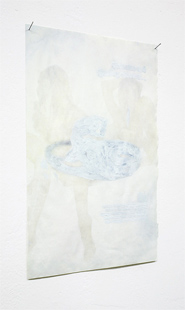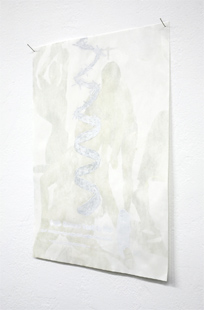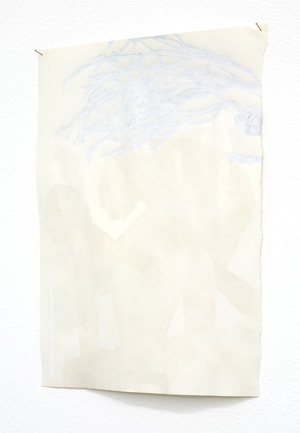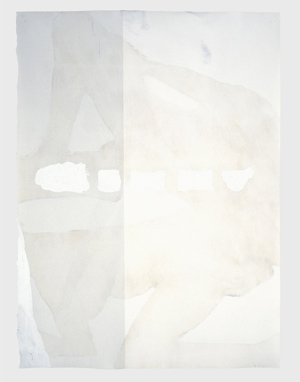Compress
Compress, 2006/7 (L) & Pit of Dublivores 1, 2006/7 (R)
works on paper drawn under the pressure of erasing other images, then corrected
ink, correction fluid, magazine pages, plus pins
each approximately 310 x 210mm
courtesy of the artist (L) & private collection, Sydney (R)
Compress
Two magazine pages come together face to face, one relatively white and empty (the 'host' sheet), the other with more printed bodies and goods to give-up under the hand-pressure of erasing the pages' reverse sides. Stain-like forms and silhouettes are imprinted, transferred from the face of one page onto the other. The host sheet is kept, the other discarded. Lastly, the original contents of the kept sheet are whited-out: only that and the image-transfer remain -- a COMPRESS.
In their largest showing to date a room of fourteen Compress, subtitled 'the pit of doublivores', was presented in NEW07 at the Australian Centre for Contemporary Art, Melbourne (2007), where they were illuminated by a specially installed fluorescent lighting system. Half of this series (from the full suite held at the Art Gallery of New South Wales as part of the Kaldor Family Collection) toured South East Asian venues in 2009/10 in the Asialink/Art Gallery of New South Wales exhibition Erased (Contemporary Australian Drawing). In early 2011 the exhibition tour concluded with a presentation at the National Art School Gallery, Sydney.
Previously, selections of the Compress appeared in Insufferable Nebulae and other couplings, Gertrude Contemporary Art Spaces (2004 - solo) and a smaller group, subtitled the 'brown study', formed part of a contribution to The body. The ruin, Ian Potter Museum of Art, Melbourne University (2005/6 - group). In 2009 there were showings in Second Hand, Engholm Engelhorn Galerie, Vienna (group) and Still Vast Reserves at the Magazzino d'Arte Moderna, Rome (group), while in 2010 they were seen in InVisible: Art at the Edge of Perception at MASS MoCA, North Adams MA, and It happened that, ST Paul St. Gallery, Auckland.
An ongoing series dating from around 2001, the Compress are presented very simply pinned to the wall.
Selections of the Compress are held in the collections of the National Gallery of Australia, Canberra, and the Art Gallery of New South Wales, Sydney.
----------
Links to Compress pages on the website:
Erased: Contemporary Australian Drawing
InVisible: Art at the Edge of Perception
Compress (pit of doublivores), 2006/7
works on paper drawn under the pressure of erasing other images, then corrected
ink, correction fluid, magazine page, plus pins
approximately 310 x 210mm
private collection, Sydney
----------
WRITINGS
What's important: forty laps back and forth at the Fitzroy swimming pool every other day to stem the headaches that come from the gut, the ones you can taste; clearing pages; the heat of the eraser; hard caressing of bodies into the page; their lambent glow; the alluring feel of classy magazine paper, crisp, while it lasts; a chemical whiteness covering things; the cast-off rubber and ink page-pile residue.
Christian Capurro, excerpt from NEW07 Interviewed
(Broadsheet: Contemporary Visual Arts & Culture vol. 36 #1, February 2007)
OTHER WRITINGS
Christian Capurro's 'Compress' works (2005) are delicate traces of gesture, impressions of a body's presence and movement through space. [They are literally the result of the pressure of a hand erasing an image from another page;] they are like the ink blotter, the page that sits behind another, quietly recording, bearing witness to the action taking place elsewhere. Gesture and the potential for the expressive qualities of gesture are translated into a secondary medium in Capurro's work, which operates as a kind of trace of gesture. In this way his work often exists between image and anti-image - having a kind of iconoclastic potential to be read as an image but also to subsume the image within its related action. Capurro describes the 'Compress' works as the 'fastidious labouring of the body against the image'. The works operate through the tension between the presence of the body and absence of the image, and the action of the body. In this manner they could be seen as being an empirical form of evidence or measure of the body's movement, like the apparatus used by work place assessors to measure the labouring body.
Bridget Crone, excerpt from The ruined body?
('The body. The ruin' catalogue, 2005)
Elizabeth Brown's NEW07 catalogue text Between Rapture and Refusal download (PDF, 53k)
Compress (the 'brown study' 3), 2005
works on paper drawn under the pressure of erasing other images, then corrected
ink, correction fluid, magazine page, plus pins
approximately 310 x 210mm
courtesy of the artist




